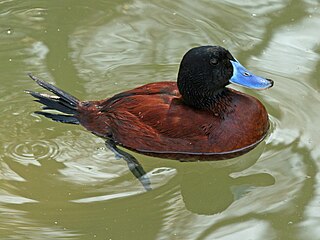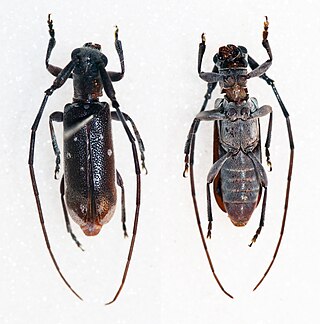
The Puerto Rican amazon, also known as the Puerto Rican parrot or iguaca (Taíno), is the only extant parrot endemic to the archipelago of Puerto Rico, and belongs to the Neotropical genus Amazona. Measuring 28–30 cm (11.0–11.8 in), the bird is a predominantly green parrot with a red forehead and white rings around the eyes. Its closest relatives are believed to be the Cuban amazon and the Hispaniolan amazon.

A grison is any mustelid in the genus Galictis. Native to Central and South America, the genus contains two extant species: the greater grison, which is found widely in South America, through Central America to southern Mexico; and the lesser grison, which is restricted to the southern half of South America.

The greater grison is a species of mustelid native to Southern Mexico, Central America, and South America.

The lake duck is a small, South American stiff-tailed duck. It is also called the Argentine blue-bill, Argentine blue-billed duck, Argentine lake duck, or Argentine ruddy duck.

The Antarctic tern is a seabird in the family Laridae. It ranges throughout the southern oceans and is found on small islands around Antarctica as well as on the shores of the mainland. Its diet consists primarily of small fish and crustaceans. It is very similar in appearance to the closely related Arctic tern, but it is stockier, and it is in its breeding plumage in the southern summer, when the Arctic tern has shed old feathers to get its non-breeding plumage. The Antarctic tern does not migrate like the Arctic tern does, but it can still be found on a very large range. This tern species is actually more closely related to the South American tern.

Grauer's warbler is a species of Old World warbler in the family Acrocephalidae.

Pteris vittata, the Chinese brake, Chinese ladder brake, or simply ladder brake, is a fern species in the Pteridoideae subfamily of the Pteridaceae. It is indigenous to Asia, southern Europe, tropical Africa, and Australia. The type specimen was collected in China by Pehr Osbeck.

Orthonama vittata, the oblique carpet, is a moth of the family Geometridae. The species was first described by Moritz Balthasar Borkhausen in 1794. It is found throughout the Palearctic realm.

Eunidiini is a tribe of longhorn beetles of the subfamily Lamiinae. It was described by Téocchi et al. in 2010.

Eunidia is a genus of longhorn beetles of the subfamily Lamiinae.

Poecilotheria vittata, sometimes called Pederson's ornamental, the ghost ornamental, or magam tiger spider, is an arboreal tarantula. It is endemic to Sri Lanka. In IUCN Red List, the species is cited as a synonym of Indian species Poecilotheria striata, but in other local text books and online publications, it is cited as a separate species. As of February 2016, the species was considered to be native to both India and Sri Lanka by the World Spider Catalog.
Eunidia fallaciosa is a species of beetle in the family Cerambycidae. It was described by Stephan von Breuning in 1939. It is known from Somalia.
Eunidia flavoapicata is a species of beetle in the family Cerambycidae. It was described by Stephan von Breuning in 1939.

Eunidia tripunctata is a species of beetle in the family Cerambycidae. It was described by Per Olof Christopher Aurivillius in 1911.
Eunidia plagiata is a species of beetle in the family Cerambycidae. It was described by Charles Joseph Gahan in 1898. It is known from Chad, Kenya, Zimbabwe, Mozambique, Ethiopia, South Africa, Botswana, and Tanzania.
Eunidia subtesselata is a species of beetle in the family Cerambycidae. It was described by Charles Joseph Gahan in 1909. It is known from Kenya, Ethiopia, and Somalia.
Eunidia batesi is a species of beetle in the family Cerambycidae. It was described by Olliff in 1889.
Eunidia caffra is a species of beetle in the family Cerambycidae. It was described by Fahraeus in 1872.
Eunidia nebulosa is a species of beetle in the family Cerambycidae. It was described by Wilhelm Ferdinand Erichson in 1843. It is known from Australia, Senegal, Cameroon, Gabon, the Democratic Republic of the Congo, South Africa, Madagascar, Ethiopia, Ivory Coast, Kenya, Namibia, Angola, Niger, Saudi Arabia, Somalia, Mozambique, Tanzania, and Zimbabwe.

Eunidia thomseni is a species of beetle in the family Cerambycidae. It was described by William Lucas Distant in 1898. It is known from Tanzania, Cameroon, Chad, Niger, Ethiopia, Senegal, Mozambique, Botswana, Namibia, Saudi Arabia, the Central African Republic, Somalia, Uganda, South Africa, Yemen, Kenya, and Zimbabwe.











